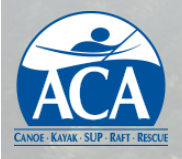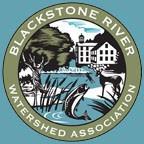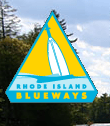Sponsors & Partners are of vital importance to BRWC/FOB
We want to recognize and thank our partners and sponsors for their support. It is with their help that we are able to accomplish our mission and continue our work for the river and our community.

BRWC/FOB gratefully recognizes Hope Global for their continuing support of our river projects. It is through these types of generous contributions from within our own community that we get the most pleasure because we can invite these companies to witness our organization in action and see firsthand the impact their support can have.

We have been awarded a grant from the ACA and LL Bean Club Fostered Stewardship Program. The grant monies will be used to support our Water Quality Monitoring Program (WQM). We have a long history of WQM efforts and are pleased that this award will help to cover some of the costs of that program. Read more about our WQM Program and its history here.
Since 2002, the ACA has partnered with LL Bean to provide funding to local and regional paddling clubs and organizations that undertake stewardship projects on waterways in their area. The program encourages clubs to take an active role in protecting and improving the nation’s waterways, something we have been doing for almost 30 years.
 Dunkin on Smith Street, Providence joined the riverlution by becoming one of our Benefactors. We very much appreciate their support. Be sure to visit them on Smith Street and thank them for supporting our efforts.
Dunkin on Smith Street, Providence joined the riverlution by becoming one of our Benefactors. We very much appreciate their support. Be sure to visit them on Smith Street and thank them for supporting our efforts.
 The Friends of the Blackstone River Environmental Center is located at 100 New River Road in the Manville section of Lincoln RI. Our dreams of an environmental center came true through the generous financial support from the Town of Lincoln and the cooperation of town leaders who granted us an easement on the property.
The Friends of the Blackstone River Environmental Center is located at 100 New River Road in the Manville section of Lincoln RI. Our dreams of an environmental center came true through the generous financial support from the Town of Lincoln and the cooperation of town leaders who granted us an easement on the property.
 We gratefully acknowledge Cumberland Quarry Corp for their considerable contributions toward the building of our Environmental Center. It is with their support that we were able to realize our dream of creating a place for river education, collaboration, recreation and environmental stewardship to help further our mission.
We gratefully acknowledge Cumberland Quarry Corp for their considerable contributions toward the building of our Environmental Center. It is with their support that we were able to realize our dream of creating a place for river education, collaboration, recreation and environmental stewardship to help further our mission.

BRWC/FOB is proud to acknowledge Navigant for helping us make the river a safer place to paddle. Safety is always at the top of our list when it comes to river activities and we are proud that Navigant agrees with our thinking.
 Founded in 1880, The American Canoe Association (ACA) is a national nonprofit organization serving the broader paddling public by providing education related to all aspects of paddling; stewardship support to help protect paddling environments; and sanctioning of programs and events to promote paddlesport competition, exploration and recreation. In addition, as a Paddle Club America member, BRWC/FOB is able to take advantage of ACA’s insurance for paddlesport outfitters, liveries, and guides. Proceeds from utilizing this insurance program benefit paddlers as they are used to support the ACA’s overall mission of improving education, stewardship, recreation and competition for all.
Founded in 1880, The American Canoe Association (ACA) is a national nonprofit organization serving the broader paddling public by providing education related to all aspects of paddling; stewardship support to help protect paddling environments; and sanctioning of programs and events to promote paddlesport competition, exploration and recreation. In addition, as a Paddle Club America member, BRWC/FOB is able to take advantage of ACA’s insurance for paddlesport outfitters, liveries, and guides. Proceeds from utilizing this insurance program benefit paddlers as they are used to support the ACA’s overall mission of improving education, stewardship, recreation and competition for all.
The Audubon Society of Rhode Island, independent and unaffiliated with the National Audubon Society, was founded in 1897. The Audubon Society of Rhode Island is dedicated to education, land conservation and advocacy. Audubon independently protects or owns almost 9,500 acres of woodlands and coastal property embracing diverse natural habitats. A voice in statewide ecological issues, the Society actively fulfills its environmental stewardship through preservation and protection of Rhode Island’s natural heritage.
 The Blackstone River Coalition is a partnership of organizations, businesses, agencies, municipalities and individuals from RI and Mass working to restore the Blackstone River and to improve the health of the watershed. Its mission is to restore and protect water quality, wildlife habitat and advocate for sound land use in the Blackstone River watershed.
The Blackstone River Coalition is a partnership of organizations, businesses, agencies, municipalities and individuals from RI and Mass working to restore the Blackstone River and to improve the health of the watershed. Its mission is to restore and protect water quality, wildlife habitat and advocate for sound land use in the Blackstone River watershed.
 The Blackstone River Watershed Association (BRWA) is a Massachusetts sister organization founded in 1976 and is dedicated to restoring, enhancing and preserving the Massachusetts section of the Blackstone River system and its watershed.
The Blackstone River Watershed Association (BRWA) is a Massachusetts sister organization founded in 1976 and is dedicated to restoring, enhancing and preserving the Massachusetts section of the Blackstone River system and its watershed.
 The John H. Chafee Blackstone River Valley National Heritage Corridor is a National Heritage Corridor dedicated to the history of the early American Industrial Revolution, including mill towns stretching across 24 cities and towns near the Blackstone River’s course in Worcester County, Massachusetts and Providence County, Rhode Island.
The John H. Chafee Blackstone River Valley National Heritage Corridor is a National Heritage Corridor dedicated to the history of the early American Industrial Revolution, including mill towns stretching across 24 cities and towns near the Blackstone River’s course in Worcester County, Massachusetts and Providence County, Rhode Island.

The Blackstone Valley Historical Society is a non-profit organization dedicated to the exploration, preservation, and appreciation of the Blackstone Valley heritage. The Blackstone Valley (in Rhode Island) is comprised of six communities: Pawtucket, Central Falls, Lincoln, Cumberland, North Smithfield and Woonsocket.
 Conservation Law Foundation of RI is New England’s leading environmental advocacy organization. Since 1966, CLF has worked to protect New England’s people, natural resources and communities.
Conservation Law Foundation of RI is New England’s leading environmental advocacy organization. Since 1966, CLF has worked to protect New England’s people, natural resources and communities.
The Cumberland Land Trust is a private, non-profit, charitable, conservation organization run by a dedicated group of volunteers. Our mission is to preserve the natural resources of Cumberland for present and future generations by preserving land for open space. Since incorporation in 1989, we have protected 641 acres of land acquired through purchase, donation and conservation easements.

Funded through a Capital Appropriations Grant with RIDEM, we were able to build our environmental center to assist us in bringing our message to the public including educating the community about the importance of the Blackstone River and the life it supports.
 The Narragansett Bay Estuary Program’s mission is to protect and preserve Narragansett Bay and its watershed through partnerships that conserve and restore natural resources, enhance water quality and promote community involvement.
The Narragansett Bay Estuary Program’s mission is to protect and preserve Narragansett Bay and its watershed through partnerships that conserve and restore natural resources, enhance water quality and promote community involvement.
![]() Natural Resources Conservation Service, is an agency of the US Department of Agriculture that provides technical assistance to farmers and other private landowners and managers.
Natural Resources Conservation Service, is an agency of the US Department of Agriculture that provides technical assistance to farmers and other private landowners and managers.
 The National Oceanic and Atmospheric Administration is an American scientific agency within the US Department of Commerce that focuses on the conditions of the oceans, major waterways, and the atmosphere.
The National Oceanic and Atmospheric Administration is an American scientific agency within the US Department of Commerce that focuses on the conditions of the oceans, major waterways, and the atmosphere.

The National Park Service Volunteers-In-Parks Program (VIP) was authorized by Public Law 91-357 enacted 1970. The primary purpose of the VIP program is to provide a vehicle through which the National Park Service can accept and utilize voluntary help and services from the public. The major objective of the program is to utilize this voluntary help in such a way that is mutually beneficial to the National Park Service and the volunteer.
 The RI Bays, Rivers, and Watersheds Coordination Team‘s mission is to protect and restore RI’s fresh and marine waters and watersheds and to promote sustainable development of RI’s water-reliant economy through inter-agency coordination and strategic planning, policy analysis, targeted investments, environmental and economic monitoring, and stakeholder communications and engagement.
The RI Bays, Rivers, and Watersheds Coordination Team‘s mission is to protect and restore RI’s fresh and marine waters and watersheds and to promote sustainable development of RI’s water-reliant economy through inter-agency coordination and strategic planning, policy analysis, targeted investments, environmental and economic monitoring, and stakeholder communications and engagement.
 The Blueways project is a comprehensive water trail network linking Rhode Island’s rivers, lakes and ponds to Narragansett Bay and to the rivers in Massachusetts that flow into the bay.
The Blueways project is a comprehensive water trail network linking Rhode Island’s rivers, lakes and ponds to Narragansett Bay and to the rivers in Massachusetts that flow into the bay.
 Rhode Island Canoe and Kayak Association (RICKA) is the founding organization of the Blackstone Valley Paddlers which promotes different paddle trips within the Blackstone River watershed.
Rhode Island Canoe and Kayak Association (RICKA) is the founding organization of the Blackstone Valley Paddlers which promotes different paddle trips within the Blackstone River watershed.
 RINHS is a consortium of organizations and individuals seeking to advance knowledge and understanding of Rhode Island’s biology, geology, and ecosystems. The Survey maintains a clearinghouse for ecological information in Rhode Island, providing sound scientific data to scientists, naturalists, educators, land managers, decision makers, and the public. The Natural History Survey manages the Rhode Island Natural Heritage Database of Rare Species and Communities.
RINHS is a consortium of organizations and individuals seeking to advance knowledge and understanding of Rhode Island’s biology, geology, and ecosystems. The Survey maintains a clearinghouse for ecological information in Rhode Island, providing sound scientific data to scientists, naturalists, educators, land managers, decision makers, and the public. The Natural History Survey manages the Rhode Island Natural Heritage Database of Rare Species and Communities.

The RI General Assembly created the RI Rivers Council to coordinate efforts to improve the quality of the state’s rivers and their watersheds. View Blackstone River Do’s and Don’ts
 Our mission is to protect and improve Narragansett Bay. Save The Bay is an independent, member-supported, nonprofit organization. We got our start as a grassroots organization in 1970 when a group of concerned citizens came together to fight an oil refinery proposed for the shores of Tiverton. Today we carry out our mission through advocacy, education, and habitat restoration and adaptation.
Our mission is to protect and improve Narragansett Bay. Save The Bay is an independent, member-supported, nonprofit organization. We got our start as a grassroots organization in 1970 when a group of concerned citizens came together to fight an oil refinery proposed for the shores of Tiverton. Today we carry out our mission through advocacy, education, and habitat restoration and adaptation.
 Senator Sheldon Whitehouse is a h3 advocate for environmental protection, health, and conservation. He has argued before the U.S. Supreme Court to protect public wetlands from development, sued to block Bush administration efforts to weaken the Clean Air Act, and led the investigation into a devastating oil spill in Rhode Island’s Narragansett Bay.
Senator Sheldon Whitehouse is a h3 advocate for environmental protection, health, and conservation. He has argued before the U.S. Supreme Court to protect public wetlands from development, sued to block Bush administration efforts to weaken the Clean Air Act, and led the investigation into a devastating oil spill in Rhode Island’s Narragansett Bay.
The Town of Cumberland along with the Cumberland Conservation Commission partner with us regularly on clean-up events in order to have a better community for its residents.

Trout Unlimited Northern Rhode Island Chapter #737. We share our knowledge of conservation, restoration, sustaining, and protection of our cold-water resources. We freely pass on our love of trout fishing and fly tying to all who ask.

The mission of the Environmental Protection Agency is to protect human health and the environment. Since 1970, EPA has been working for a cleaner, healthier environment for the American people.
 The United States Fish and Wildlife Service is an agency of the US federal government within the US Department of the Interior dedicated to the management of fish, wildlife, and natural habitats.
The United States Fish and Wildlife Service is an agency of the US federal government within the US Department of the Interior dedicated to the management of fish, wildlife, and natural habitats.
 Get real-time Blackstone River levels: The US Geological Survey WaterAlert service sends email or text messages when certain parameters, as measured by a USGS real-time data-collection station, exceed user-definable thresholds. Real-time data from USGS gages are transmitted via satellite or other telemetry to USGS offices at various intervals; in most cases, 1 to 4 times per hour. Emergency transmissions, such as during floods, may be more frequent.
Get real-time Blackstone River levels: The US Geological Survey WaterAlert service sends email or text messages when certain parameters, as measured by a USGS real-time data-collection station, exceed user-definable thresholds. Real-time data from USGS gages are transmitted via satellite or other telemetry to USGS offices at various intervals; in most cases, 1 to 4 times per hour. Emergency transmissions, such as during floods, may be more frequent.



